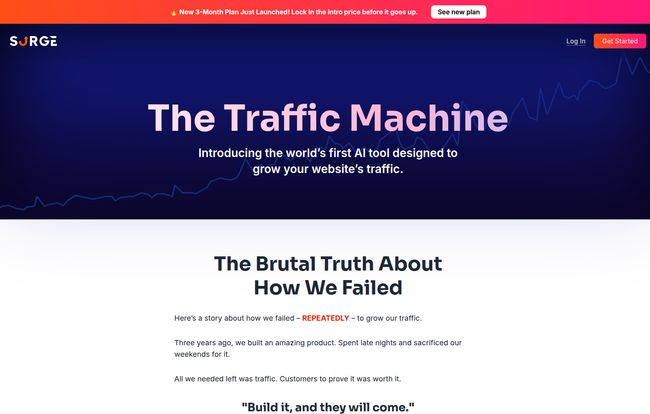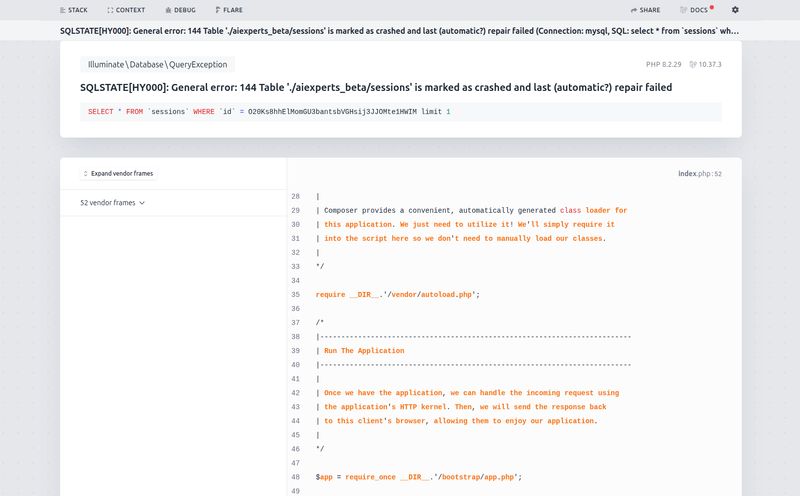For years, I’ve been in the SEO trenches. I’ve chased algorithms, built links until my fingers were sore, and written more 2,000-word articles than I can count. We were all told the same thing: “Content is king.” and “Just be patient.” So we wrote, we waited, and for many of us... crickets. The traffic needle just wouldn't budge.
Then came the AI explosion. Suddenly, tools were everywhere, promising to automate the content grind. I was excited. Cautiously optimistic, anyway. We all jumped on board, churning out dozens, even hundreds of articles. The result? A whole lot of perfectly mediocre content that Google, and more importantly, actual humans, promptly ignored. It felt like we’d just swapped one hamster wheel for a faster, more expensive one.
So when I first saw SurgeGraph calling itself a “Traffic Machine,” my inner skeptic rolled its eyes so hard I think I sprained something. Another magic pill? But I kept reading, and what I found was… different. They weren't just selling an AI writer; they were selling a philosophy about traffic. A philosophy born from the same failures many of us have faced. So, I decided to take a proper look.
The Old SEO Playbook is Broken
For a long time, the game was about signals. Get more backlinks. Stuff the right keywords. Match the word count of the top result. We treated Google like a simple-minded machine that could be tricked. We followed the so-called experts, bought the tools, and waited for the promised traffic that never came.
SurgeGraph’s own origin story, which they are surprisingly open about, starts right here. They admit they fell into this trap. They built a product, told themselves “build it and they will come,” and… they didn’t. Ouch. That kind of honesty is pretty rare in this space.
Then Came the Empty AI Promise
AI was supposed to be the great equalizer. And in a way, it was. It made everyone capable of producing massive amounts of content. The problem is, most of it is just a rehash. AI models are trained on existing internet data, so their default state is to just summarize what's already out there. The result is a sea of bland, soulless articles that all say the same thing. Google's getting smarter, and its Helpful Content Update is basically a giant BS-detector for this kind of stuff. It’s looking for content that actually helps people, not just repeats information.
What SurgeGraph Claims to Do Differently
This is where it gets interesting. SurgeGraph isn’t positioning itself as just another writer. They claim to have cracked the code on what they call “Traffic-Generating Content.” It’s not some mystical secret, but a trifecta of common-sense principles that are surprisingly hard to execute manually.
- Grab Google’s Attention with “Information Gain.” This is a big one. Instead of just rewriting what’s on page one, the tool focuses on finding and adding new information. Think unique insights, fresh perspectives, or data points that other articles miss. It’s about giving Google a reason to show your content over the established players because you bring something new to the table.
- Write Like a Human. This sounds obvious, but it’s a huge failing of most AI content. We can all spot it a mile away—it’s stiff, repetitive, and boring. SurgeGraph has built-in features specifically to make the content sound like an actual person wrote it, bypassing those cringe AI-detection scores and, more importantly, not putting your readers to sleep.
- Be Better Than The Best. This is about building topical authority. You can't just write one good article. To dominate a niche, you need to cover it comprehensively. The tool is designed to help you create content that is not just as good as, but better than everything else ranking for your keyword.
It’s not about tricking the algorithm. It's about giving the algorithm (and the user) exactly what it wants: genuinely helpful, interesting, and comprehensive content. It’s a content strategy, baked right into the software.

Visit SurgeGraph
A Look Inside the “Traffic Machine”
So how does it actually do all this? I took it for a spin. The process is smoother than I expected. You don't just give it a keyword and hit 'go'. It's more thoughtful.
It Starts with a Smart Plan
First, you use their Topic Discovery tool. You drop in a keyword, and it generates a whole content plan with hundreds of related topics to build out your topical authority. From there, you pick one and move to the Vertex AI Writer. This is where the magic starts. It analyzes the top-ranking pages, pulling in over 180,000 data points to create a super-detailed outline designed to beat them on every level. You can see the structure, the headings, and the key points it plans to cover before a single word is written.
More Than Just Writing
The writing process itself has a ton of cool features. You can set a brand voice, automatically add internal links to your other content (a huge time-saver for SEO), and use their “Content Vision” to generate relevant AI images. The whole process is designed to take you from an idea to a fully optimized, 5,000-word article in minutes. It's like having a junior SEO and a content writer working for you around the clock.
Proof is in the Pudding: The 100-Day Challenge
Here’s what I really respect. They put their money where their mouth is. They ran a public case study: take a brand new site and try to hit 100,000 monthly traffic in 100 days using only SurgeGraph content. No backlinks, no fancy tricks.
Did they hit it? No. And they’re totally upfront about it. But what they did achieve was a staggering 35,782% traffic growth, resulting in over 6,000 monthly visitors in just a few months. For anyone who's ever built a site from scratch, you know that's an insane result. Seeing that traffic graph spike upwards is the kind of thing we all dream of. Their honesty about not hitting the moonshot goal makes the actual, impressive result even more believable.
How Much Does SurgeGraph Cost?
Okay, the all-important question. It's a subscription service, and they have a few tiers. They are very clear that this is a long-term play, and the pricing reflects that. You get a better deal for committing longer.
| Plan | Price (per month) | Best For |
|---|---|---|
| 1 Month | $49.99 | Testing the tool's features and workflow. |
| 1 Year | $29.92 (billed yearly) | Bloggers and businesses committed to consistent content and traffic growth. |
| 3 Years | $19.42 (billed every 3 years) | The serious SEO or agency looking for the absolute best long-term value. |
All plans come with the core features, including 30 monthly article credits (with the AI writer) and the option to 'Bring Your Own Key' (BYOK) from OpenAI to write up to 2,000 articles per month for much cheaper. There's also a 14-day money-back guarantee, but they rightly point out that you won’t see major traffic gains in two weeks. It's enough time to see if you like the tool, not enough time for Google to fall in love with your new site.
The Good, The Bad, and The Realistic
No tool is perfect. After spending time with SurgeGraph, here's my honest take. The best part is its laser focus on traffic as the end goal. It’s not just about creating content; it's about creating content that ranks. The built-in SEO strategy, the “Information Gain” feature, and the automated internal linking are brilliant. It saves an incredible amount of time on the research and planning side of things, which is often where the real work lies.
On the flip side, this is not a magic wand. You still need a brain. You need to pick the right topics, review the AI-generated content, and inject your own personal expertise and stories. It’s a powerful assistant, not a replacement for a strategist. Also, the biggest hurdle is psychological: you have to be patient. Traffic growth is a slow burn, not a firework. You have to commit to publishing consistently for a few months before you'll see those beautiful, upward-trending charts. It requires a subscription and a commitment, which might not be for everyone just dipping their toes in the water.
So, Is SurgeGraph Worth It? My Final Verdict
I’ve seen a lot of tools come and go. Most overpromise and underdeliver. SurgeGraph feels different. It feels like it was built by people who have actually been in the SEO trenches and understand the frustration.
If you’re a solopreneur, a small business owner, or a blogger who is tired of the content treadmill and wants a smarter way to grow organic traffic, I think SurgeGraph is absolutely worth a serious look. It automates the most tedious parts of creating high-ranking content, allowing you to focus on strategy and your own unique voice.
However, if you're looking for an instant, push-button solution to get to page one overnight, this isn't it. Nothing is. But if you’re willing to play the long game and partner with a seriously intelligent tool, SurgeGraph could be the key to finally achieving that traffic growth you've been working so hard for.
Frequently Asked Questions
Can SurgeGraph completely replace a human writer?
Not entirely. It's best used as a powerful co-pilot. It handles about 90% of the heavy lifting—research, outlining, drafting, and optimizing. But the best results will always come from a human adding their own final touch, personal stories, and unique expertise.
How long does it really take to see traffic with SurgeGraph?
Based on their own case study, you should expect to wait. They saw initial traffic within weeks, but the significant 'Surge Effect' took about 71-93 days to really kick in. SEO is a marathon, not a sprint, even with a powerful tool.
What is this 'Information Gain' feature exactly?
It's a core part of their system. The AI actively looks for unique angles, fresh data, or subtopics that the current top-ranking articles have missed. This makes your content more valuable and gives Google a compelling reason to rank it highly.
Is SurgeGraph better than just using ChatGPT for SEO content?
In my opinion, yes, by a long shot. ChatGPT is a general-purpose language model. SurgeGraph is a specialized system built from the ground up for one purpose: creating long-form SEO content that drives traffic. It includes competitive analysis, SEO optimization, and strategic planning that you just don't get from a standard chatbot.
What does BYOK (Bring Your Own Key) mean?
It means you can connect your own OpenAI API key to SurgeGraph. This allows you to generate a huge volume of content (up to 2,000 articles a month) at a much lower cost than using the included credits, since you're paying OpenAI's direct, cheaper rates for the generation.
References and Sources
- SurgeGraph Official Website
- SurgeGraph Pricing Information
- Google's Guidance on Creating Helpful, Reliable, People-First Content



